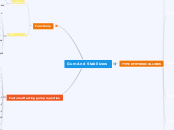by nurul husna bt che saad 8 years ago
525
Gum And Stabilizers
Gums and stabilizers are essential polysaccharides with hydroxyl groups that have the capacity to bind water, often possessing additional side chains like ester, sulfates, and acetyl.

by nurul husna bt che saad 8 years ago
525

More like this
What is Gum?
-Is a polysaccharides chains contain hydroxyl group which can bind to water.
- Also have side chains such as ester, sulfates and acetyl.
- Some gums are react strongly in presence of other ingredients. Example : sodium alginate does react actively with calcium.
Functions & Applications
1- Adhesive - Bakery glaze
2- Crystallization - Ice- cream
3- Cloud Agent - Fruit juice
4- Emulsifier - Salad Dressing
5- Film former - Sausage casing
6- Foam stabilizers - Beer, Whipped topping
7- Geling agent -Puddings
8-Suspending agent - Chocolate milk
9-Syneresis in inhibitor - Cheese, frozen foods
10- Thickening agent- sauces and gravies
CELLULOSE:
-Derived using alkaline treatment which convert cellulose into an ether (e.g: CMC - sodium carboxythylcellulose and HPMC-Hydroxypropylmethylcellulose.
CMC:
:Monovalent salts, soluble
:Divalent salt, hazy
:Trivalent salts, gel or precipitate
:React with proteins to increase viscosity of dispersions
CMC PROPERTIES
:Water soluble
:Pseudoplastic dispersions
:Stable at pH 5-10, best pH 7-9
CMC USAGE
: Pie filling-to prevent synersis
: Breads- Has an anti-staling effect
: Dietatic food- to provide bulk and body replacer that normally given by sucrose
*MC and HPMC formed gel when heated and return to it original liquid viscosity when cooled.
PECTIN derived from peel of citrus fruits
STRUCTURE:
-Chain of polygalacturonic acid units
Molecular weight up to 150,000
TYPES:
-HMP (High methoxyl pectin)- DE>50%
:To form gels, soluble solid content : 55-58%, pH 2.8-3.8
:Used in jams
:Not heat reversible
: Gels at high solids and low pH
-LMP(Low methoxyl pectin)-DE<50%
:DE < 50 %
:LM are heat reversible
:-Conventional low methoxyl pectin (LMP)
-Amidiate low methoxyl pectin (ALMP)
: The presence of Ca2+ needed to form gels with low solid content and wide pH range 1-7
:ALMP is very reactive than Conventional low methoxyl pectin
USES:
-Jams
-Jellies
XANTHAN GUM
-polysaccharides produced from fermentation of CHO substrate with Xanthomonas Campestris
STRUCTURE:
-Basically a derivative cellulose
XANTHAN PROPERTIES:
-Xanthan is soluble in hot or cold water to produce dispersion of high viscosity at low concentration
-The dispersion are highly pseudo-plastic (shear-thickening)
USES:
1)Beverages
-good flavor release ( due to shear-thickening)
-Cloud stabilizers
2) Frozen food
-Pie filling-Increase freeze-thaw stability
3) Relishes
-Good acids stability
4) Xanthan -LBG gels and puddings
-Instant gels and pudding
ALGINATE ( Source = brown seaweed, Macrocystis pyrifera)
STRUCTURE:
- D- mannuric acid, L- guluronic acid
-Poly M blocks
-Poly G blocks
-Alternating M-G blocks
PROPERTIES:
-Low molecular weight fractions
-Non-newtonian behavior increase with:
-Increasing degree of polymerizations (DP)
- Increasing concentrations
- Presence of Ca+ instead of Na+
-As temperature increase, viscosity decrease
-Good stability in the pH range 5-10
-maximum viscosity occur between pH 6-8
-Degradation occurs at low pH 1-4
-Alginate is fairy resistant to microorganism
ALGINATE GELATION:
-Ca+ gels
-Acid gels
-Combination gels
*can form heat stable gel
*Sodium alginate react strong with calcium produce alginate thick when mixed in water, but if calcium was added it will form a cold water gel.
USES:
1) Ice-cream
2) Bakery icing
3) Bakery jelly
4) Meringues
5) Salad dressing
6) Pimento stuffe olives
7) Frozen reformed onion rings
GUAR GUM
(SOURCE: cyamopsis tetragonolobus)
- hydrates rapidly in cold water to give highly viscous dispersion.
-Totally soluble in cold and hot water, and gives slimy solutions.
-Good synergism with xanthan gum for extra high viscosity solutions.
STRUCTURE:
- Galactomannans which containing mannose and galactose monomers (ratio= 2:1)
- Molecular weight : 1,000,000 to 2,000,000 daltons.
Uses:
-Processed cheese
-Ice-cream
-Baked goods
-Meat
- Dressing and sauce
-Beverages
LOCUS BEAN GUM (SOURCE : CAROB TREE (ceretonia siliqua)
STRUCTURE:
- A galactomannan ( man : gal = 4:1)
- Molecular weight = 300,000 to 360,000
*contain long stretches of bare mannose backbone which responsible for synergism
SOLUBILITY:
-Partially soluble in cold water but only under strong agitations. Totally soluble in hot water.
SYNERGIES:
- Good synergism with xanthan gum for every elastic chewy gum. Can built up quite strong gels. Useful in mayonnaise which required strong gels.
APPLICATION:
- Used in ice-cream, cheese productions and meat product
ADVANTAGE:
- Have strong interaction with K-caraggenan
-Good flavor release
GUM ARABIC - from Acacia senegal L
STRUCTURE:
- D-galactose, L-arabinose, L- rhamnose, D- glucurunic acid
- Molecular weight : 250,000 to 1,000,000
- Very complex structure
ADVANTAGES:
- High water solubility
- Flavor encapsulations
APPLICATION:
- Emulsification (w/o or o/w) in salad dressing
- Flavor fixation in powder drinks milk
- Crystallization control in ice-cream